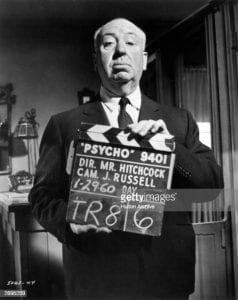
British film director Alfred Hitchcock holding up a clapperboard on the set of his film, ‘Psycho’, USA, 29th January 1960.
This week I wanted to post a paper that I wrote for my CINE 355 class, which focuses on the blockbuster.
For this paper I will be writing about Alfred Hitchcock’s 1960 horror classic Psycho and it’s reception by feminist film theorists and writers. To do so I will be looking at the reading from Tania Modleski’s book The Woman Who Knew Too Much. In the introduction to her book Modleski makes it clear that she does in fact see Hitchcock and his films as being sympathetic towards women and their role in the patriarchal society that they lived in when Hitchcock made his films; while also understanding the other side, which sees Hitchcock as misogynistic. She expresses her thoughts and opinions on the matter by referring to other film theorists and thinking about how they view the widely explored topic. I will also use Laura Mulvey’s Visual Pleasure and Narrative Cinema, which is mentioned by Modleski in her essay, to combat Modleski’s points; seeing as, it is such a two sided topic as Modleski herself explains.
Modleski does a fantastic job in explaining her position in the debate about Hitchcock and his treatment of women and feminism alike in his films. She embraces the idea that “his work is characterized by a thoroughgoing ambivalence about femininity—which explains why it has been possible for critics to argue with some plausibility on either side of the issue… despite the often considerable violence with which women are treated in Hitchcock’s films, they remain resistant to patriarchal assimilation.” (Modleski, 3). She is concerned with the way the maculine and femine identities of these characters are bound together in Hitchcock’s films. Modleski advocates for the position that it is not simply a yes or no answer when referring to Hitchcock and feminism. She claims that the answer is multifaceted and lies within each different person’s point of view. For example, Modleski writes about a fellow writer by the name of Robin Wood who views Hitchcock’s films as entirely misogynistic. Although she understands Wood’s position, she acknowledges the mindset of other feminist critics who feel that “despite the often considerable violence with which women are treated in Hitchcock’s films, they remain resistant to patriarchal assimilation” (Modleski, 3). In other words, despite their treatment and the way women in the Hitchcock world are dealt with, they rarely succumb to the patriarchy.
In her essay “Visual Pleasure and Narrative Cinema”, Laura Mulvey voices her feelings towards Hitchcock and his treatment of women characters in his films. From Mulvey’s perspective Hitchcock is only interested in creating passive female characters who are objects to be looked at by the male characters. The male characters are able to inflict any of their sadistic impulses onto the female. She explains her thoughts on the matter here:
His heroes are exemplary of the symbolic order and the law — a policeman (Vertigo), a dominant male possesing money and power (Marnie) — but their erotic drives lead the, into compromised situations. The power to subject another person to the will sadistically or gaze voyeuristically is turned on to the woman as the object of both. Power is backed by a certainty of legal right and the established guilt of the women (evoking castration, psychoanalytically speaking) (65-66).
Mulvey is saying that the strong, dominant male lead is only led astray by the women they encounter during the film. In other words, the women lead the men to their “castration” because of their incessant need to see the woman as an object of their desire. Mulvey makes a point, to examine the voyeuristic and sadistic tendencies of not only the males in the film, but those of the intended males who will see the film. In fact this is one of the main focuses of the essay. She explores this idea of “active looking” (Mulvey, 67), where the male is the spectator and the female is the object of interest. Voyeurism is to gain pleasure by watching someone when they are naked or engaged in any kind of sexual activity. This is something that can be seen in Psycho. Although there is never a shot of her naked body, Marion’s shower scene implies that she is naked; therefore, when Norman watches her and eventually kills her, he takes on a voyeuristic role. Another example from Psycho that backs up Mulvey’s point of view is the fact that Norman attempts to blame his mother for all that has gone wrong. As a viewer we know that this is not true because of “the mother’s” final words at the end of the film where she claims her innocence.
Although Modleski sees Mulvey’s classification as a bit one sided, it is obvious that both writers make a fine point. Hitchcock’s films may not be outwardly feminist, but they do allow for a feminist perspective to dive into his films and uncover things that may not have been so obvious to audience members at the time of these films releases.
Works Cited
Modleski, Tania. “Introduction.” The Woman Who Knew Too Much. 2005.
Mulvey, Laura. “Visual Pleasure and Narrative Cinema.” 1975.
